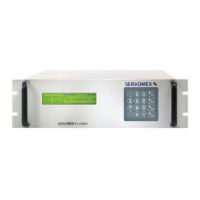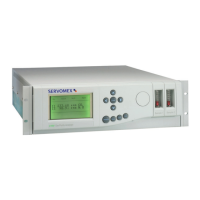5.8
The windows are usually ground from optical grade single crystal material and as such
may be EXTREMELY EXPENSIVE. The windows may have special anti-reflective
coatings and they may easily be damaged by brittle fracture. The standard material
chosen by Servomex is Calcium Fluoride. This material is non-toxic and reasonably
robust. However, some applications may require materials such as Germanium,
Barium Fluoride, Zinc Selenide, etc. which are toxic and must be handled with extreme
care. See the Manufacturing Data Sheet at the front of this manual for details of the
windows fitted.
Windows should be kept optically clean, i.e. free from dirt, scratches, grime, grease,
fingerprints etc. When handling windows it is recommended that cotton gloves or finger
cots be worn.
Cleaning of the cell windows should be carried out using cotton buds or lens tissue,
detergent and/or a suitable solvent such as Isopropanol. Avoid abrasive cleaning
compounds, as these will damage the optical surface.
To remove the cell windows proceed as follows:
Ensure that the end bosses have been removed from the cell body. Starting at one end
first, unscrew and remove one locking ring with a cell key (supplied in Special Tools Kit
Servomex p/n S2500979). Remove the 5 wavy washers, spacer, and 'O' ring being
careful not to damage them or the window. To remove the window, seal the outlet and
with the cell in a vertical position, connect a hand operated aspirator (Servomex p/n
2387-0514) to the inlet. Apply a gentle pressure to lift the window up squarely and
remove it. Finally remove the PTFE gasket. Dismantle the other end of the cell in a
similar manner.
The 'O' ring spacer is threaded internally. The Special Tools Kit Servomex p/n
S2500979 contains an extractor, which screws into the spacer to aid removal.
The windows may now be carefully cleaned. The cell body may also be cleaned as
necessary.
WARNING – ZINC SELENIDE
If windows of zinc selenide are fitted and have been damaged by acidic attack
(e.g. acidic condensate or organic acids have entered the cell) it will be likely
that some of the zinc selenide will be reduced to selenium metal. This is
highly toxic and on no account should attacked zinc selenide material be
handled with bare fingers. Such material should be bagged and disposed of
according to local regulations.
WARNING
The use of some solvents (iso-propyl alcohol, alcohol etc.) constitutes a
hazard. These substances must be handled in accordance with the relevant
local standards.

